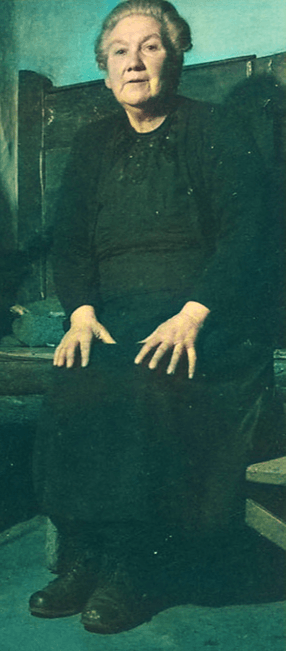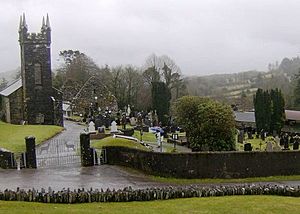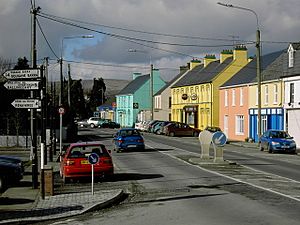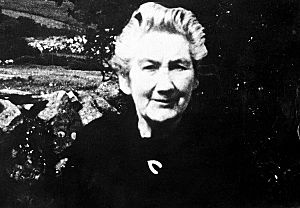Elizabeth Cronin facts for kids
Quick facts for kids
Elizabeth Cronin
|
|
|---|---|
| Eibhlís Uí Chróinín | |

Cronin, c. 1950s
|
|
| Born |
Eibhlís Ní Iarlaithe
29 May 1879 Ballyvourney, County Cork, Ireland
|
| Died | 2 June 1956 (aged 77) Macroom, County Cork, Ireland
|
| Known for | Sean-nós singing |
| Children | 5, including Donncha Ó Cróinín |
| Relatives | Dáibhí Ó Cróinín (grandson) |
Elizabeth "Bess" Cronin (Irish: Eibhlís Uí Chróinín; 29 May 1879 – 2 June 1956) was a very important singer of Irish traditional music. She was famous for her special "sean-nós" style, which means "old style" singing. Bess knew hundreds of songs that she learned when she was young. About half of these songs were in the Irish language, which was her first language.
Many famous music experts, like Alan Lomax, Jean Ritchie, Peter Kennedy, and Seamus Ennis, visited and recorded her songs. Some of her songs even inspired popular bands. For example, her version of Siúil a Rún was later sung by groups like Clannad and Celtic Women.
Contents
Bess's Early Life and Family
Elizabeth Cronin was born on May 29, 1879, in a place called Ballyvourney in County Cork, Ireland. Her birth name was Eibhlis Ní Iarlaithe. People often called her 'Bess'. Later, she became known as 'The Muskerry Queen of Song' or 'The Queen of Irish Song'.
Bess was the oldest daughter of Maighréad Ní Thuama and Seán Ó hIarlaithe. Her father was a village headmaster, which is like a principal, so people called him 'Máistir' (meaning 'Master'). He taught in a school near the Cork-Kerry border.
Bess had five other brothers and sisters: Mary Anne, Johanna, Nora, Ellie, and Tom. She also had two half-brothers, Dan and Tim, from her father's first marriage. Her whole family spoke Irish as their main language. They worked hard to help keep the Irish language alive. Her mother was even a professor of the language!
Learning Songs and Stories
As a teenager, Bess lived on a nearby farm owned by her aunt and uncle. She learned many of her songs and stories from the farm workers who stayed there for a few months at a time. She also learned songs from her mother, cousins, and friends.
Because Bess's father was a teacher and her grandfather and uncle loved books, she was around books and reading more than most people back then.
After she married Seán Ó Croinin, she moved to the Cronin family farm. This farm was known as 'The Old Plantation' in Baile Mhic Íre. Bess lived in the Baile Bhuirne area her entire life.
Bess's Music and Recordings
Bess Cronin sang songs in both English and her local Irish dialect. Her unique Irish dialect was very interesting to the people who collected traditional music.
Her first public performance was in 1899 when she was 20 years old. She sang two "sean-nós" songs in Irish at a festival called a Feis in Macroom. When she was young, she often sang at weddings and parties. She also sang to pass the time while milking cows.
Many important people visited and recorded Bess's songs. These included The Irish Folklore Commission, Seamus Ennis and Marie Slocombe from the BBC, Peter Kennedy, Jean Ritchie and George Pickow, Diane Hamilton, Brian George, Robin Roberts, and the music expert Alan Lomax. Lomax even put her songs in a special collection of folk music from around the world.
Over 80 of Bess Cronin's songs are on tape recordings. However, many of these are kept in private collections and are not available for everyone to hear. Even though she was so talented, she never got a recording contract for her traditional Irish music.
Her sons, Donncha and Sean, helped record many of their mother's songs. Her grandson, Daibhi O Croinin, who is a history professor, put together a book with 200 of her songs. Later in her life, some of her music was put into a collection called "The Commercial Recordings."
Illness and Death
Towards the end of her life, it became clear from her recordings that Bess was getting very tired and found it hard to sing. She became ill with blood-related conditions called toxaemia and anaemia. Elizabeth Cronin passed away on June 2, 1956, when she was 77 years old.
Bess's Lasting Legacy
Séamus Ennis called Bess Cronin the "Muskerry Queen of Song" because she was so good.
She made some recordings during her life that are still available today in the Irish Traditional Music Archive. These recordings help keep her music alive.
The music and words from her version of Siúil a Rún became the basis for many other recordings. This includes songs by famous groups like Clannad and Celtic Women. Bess also influenced other Irish singers such as Christy Moore and Martin Carthy, and Seamus Ennis. Her songs are still played on RTÉ Radio and you can find them on YouTube and Spotify.
Bess's continued use of her local Irish dialect helped to strengthen her local community.




